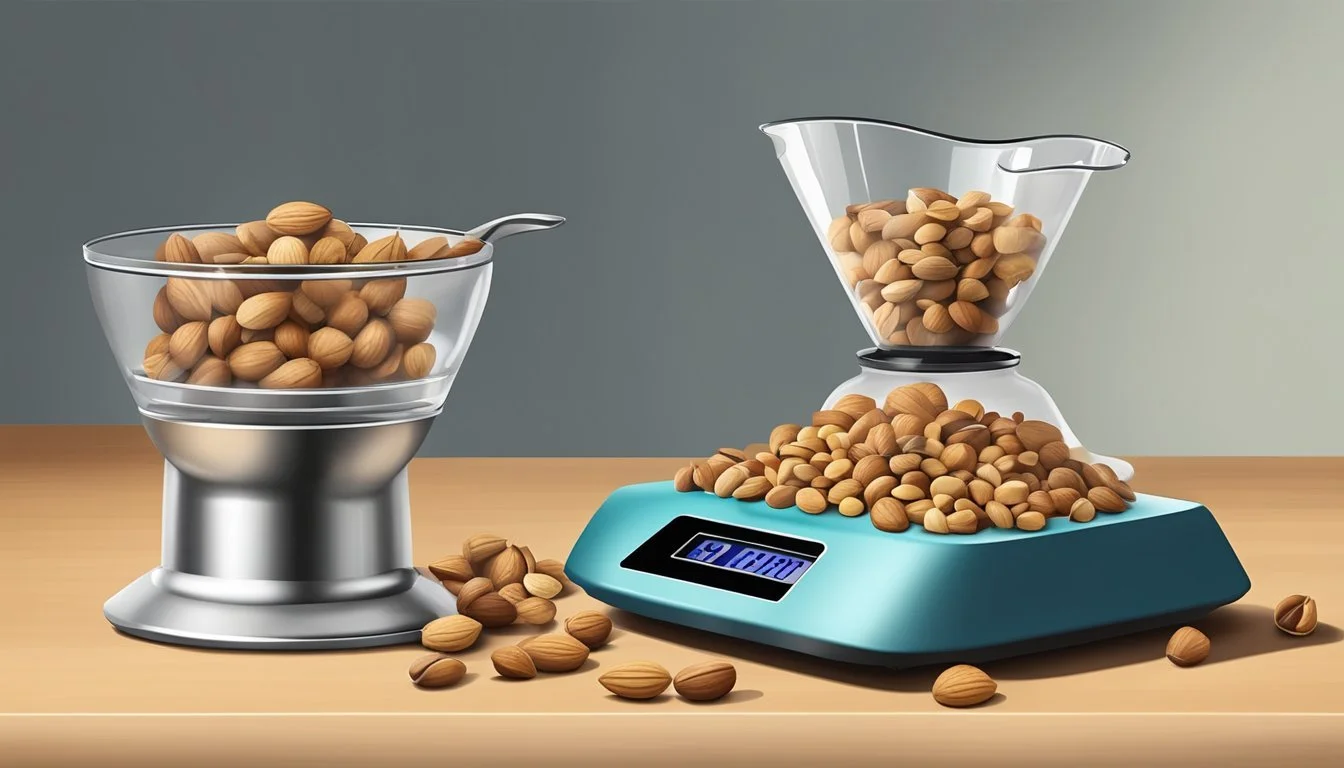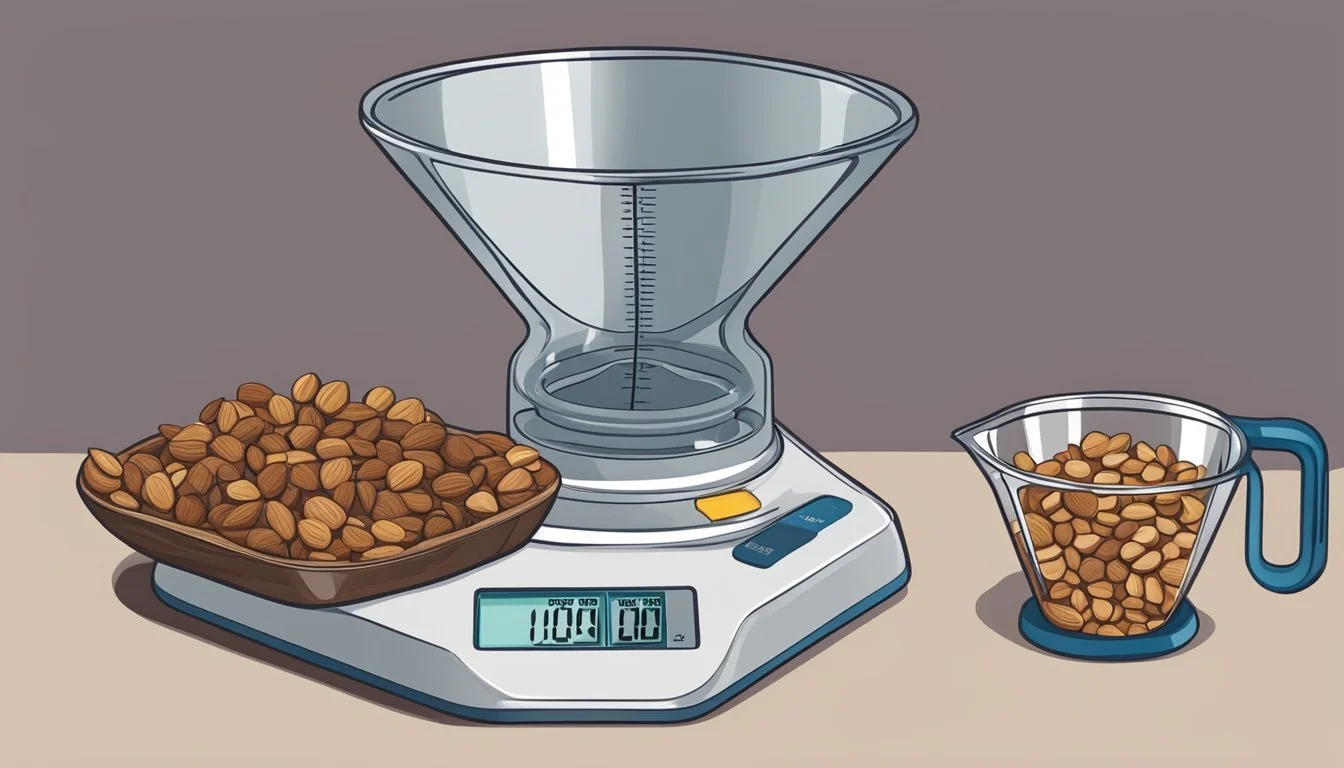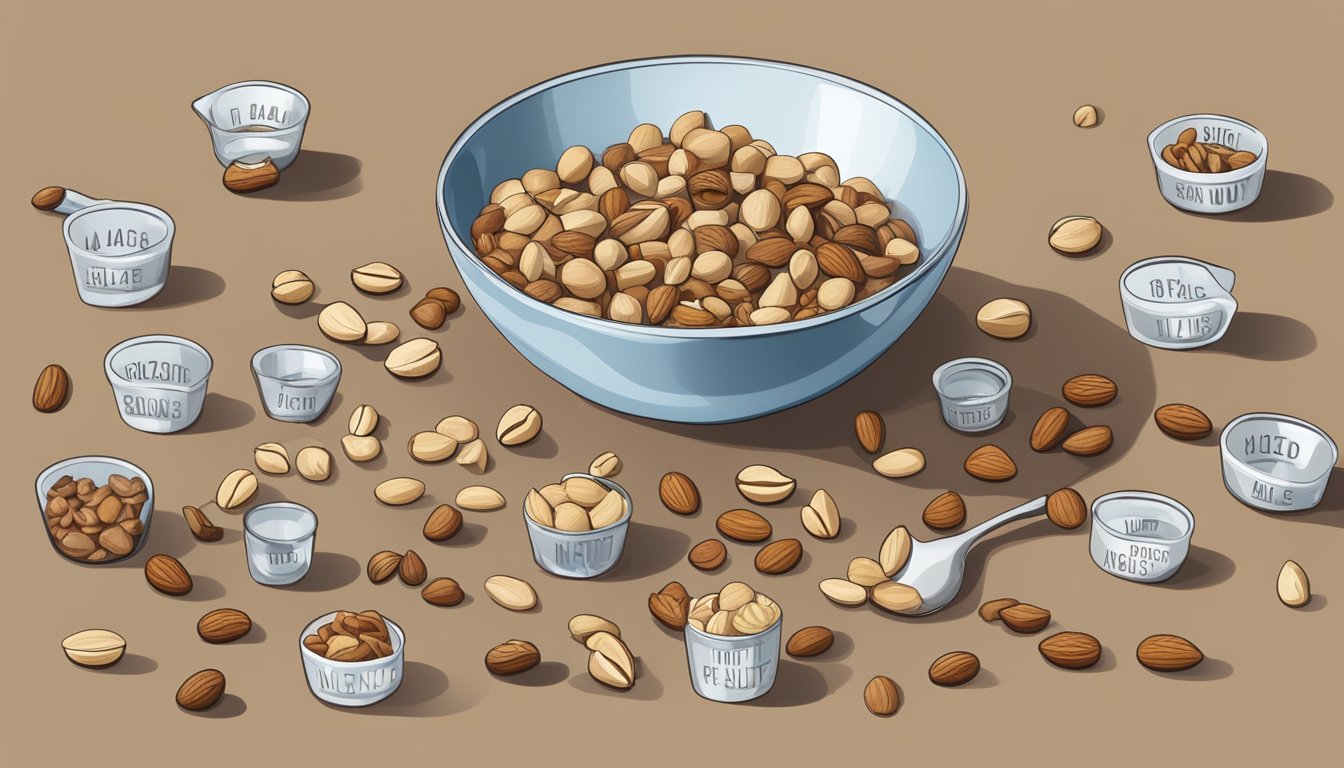How Many Cups in a Pound of Nuts
A Quick Measurement Guide
When preparing recipes that call for nuts (What wine goes well with nuts?), knowing the conversion of weight to volume can be critical, especially in activities like cooking and baking where precision counts. Nuts are often sold by weight, typically in pounds, but many recipes require measurements in cups. This can lead to confusion, as the conversion is not always straightforward due to the varying densities and sizes of chopped nuts.
A pound of nuts can convert to a differing number of cups based on the type of nut and how finely they're chopped. Generally, one pound of chopped nuts is approximately equal to 4 cups. However, this can vary slightly. For example, chopped macadamia nuts may yield around 2.7 cups per pound, indicating that a general rule requires adjustments for specific types of nuts.
Understanding this conversion is useful across culinary disciplines, from baking rich nut cookies to crafting savory toppings for salads. Peanuts, almonds, walnuts, or any variety of nuts add texture and flavor to dishes, making accurate measurement key to success. Whether weighing nuts for a crust or measuring them for a filling, cooks will find that mastering the pound-to-cup ratio ensures their dish turns out perfectly every time.
Understanding Weights and Measures
In the context of cooking, grasping the difference between weight and volume is crucial, as they are fundamental concepts used in recipe measurements.
The Basics of Mass and Volume
Mass refers to the amount of matter in an object and is measured in units of weight such as pounds, ounces, grams, or kilograms. On the other hand, volume measures the space that an object occupies, commonly in volume units like liters, milliliters, cups, and tablespoons.
Units of Measurement Used in Cooking
Cooking typically involves two main types of measurements: weight and volume. Weight is measured in units like pounds (lbs), ounces (oz), grams (g), and kilograms (kg), while volume is measured in units such as cups, tablespoons (tbsp), teaspoons (tsp), liters (L), and milliliters (mL).
Unit of Mass: pounds, ounces, grams, kilograms
Unit of Volume: cups, tablespoons, teaspoons, liters, milliliters
Weight to Volume Conversion Principles
When converting weight to volume, factors like the density of the material must be considered. This is because a cup of one substance, such as chopped nuts, does not weigh the same as a cup of another, such as sugar. Moreover, the weight of a commodity in pounds does not necessarily translate to a predictable cup measurement due to varying densities and consistencies. For example, one pound of medium chopped nuts roughly equates to 4 cups, but this can diverge with the fineness or coarseness of the chop.
Converting Nuts from Pounds to Cups
When converting nuts from pounds to cups, precision is essential due to varying densities and cuts. The following subsections provide a structured approach to ensure accurate conversions.
General Conversion Formula
To convert pounds of nuts to cups, one needs to know the specific volume that a pound of nuts occupies. Though the conversion is not uniform across all types of nuts due to differing sizes and densities, a general formula can be used as a starting point:
Cups = Pounds × Cups per Pound
The exact value for 'Cups per Pound' varies for each type of nut and should be adjusted according to the table provided below.
Role of Density in Conversion
The density of nuts affects how many cups are in a pound. Denser nuts will have more cups per pound, while less dense nuts will have fewer. Chopped nuts occupy more space due to air between pieces, which means a pound of chopped nuts will fill more cups than a pound of whole nuts.
Common Nuts Conversion Chart
Below is a conversion chart that outlines approximate cups per pound of various nuts based on their rough average density:
Type of Nut Cups in 1 Pound (chopped nuts) Cups in 1 Pound (whole nuts) Almonds 3.2 - 3.3 2.4 - 2.5 Walnuts 3.4 - 3.5 2.6 - 2.7 Pecans 3.5 - 3.6 2.7 - 2.8 Macadamia Nuts 3.2 - 3.3 2.7 - 2.8 Peanuts 3.5 - 3.7 2.6 - 2.7
Note: These values can vary based on the size of the nut pieces and personal measurement method. Always use the same method for measuring to maintain consistency.
Measuring Ingredients Accurately
In baking, the difference between a good result and a great one often lies in the precision and accuracy of measuring ingredients. The following subsections delve into why precision matters, which tools are best for accurate measurements, and how to adjust measurements for specific ingredients such as nuts.
The Importance of Precision in Baking
Precision is crucial in baking because it ensures the chemical reactions necessary for creating texture and flavor occur as expected. Accuracy means measuring the correct amount, while precision involves consistently measuring the exact amount required by the recipe. A deviation can lead to a compromised texture or taste.
Using the Right Tools for Measuring
To guarantee accuracy and precision, using the correct tools is essential. For dry ingredients, like nuts, a measuring cup specifically designed for dry ingredients should be used. Digital kitchen scales also provide the most accurate measurements, especially for ingredients with variable densities:
Measuring cups: Best for volume measurements.
Scales: Best for weight measurements, providing consistent accuracy.
Tool Purpose Advantage Measuring Cup To measure volume of ingredients Quick, generally accessible Scale To measure weight of ingredients Provides precision and consistent measurements
Adjusting Measurements for Specific Ingredients
Different ingredients have different densities and may settle or clump, affecting the accuracy of measurements. With nuts, for example, a cup of whole nuts will contain more air space than a cup of chopped nuts. Therefore, the weight-to-volume conversion might need adjustment. Pounds to cups conversions for nuts are often provided in recipes or conversion charts. When unavailable, general guideline:
1 pound of nuts ≈ 3 to 4 cups (depending on the size and chop)
Ensuring consistent chop size or using weight rather than volume will lead to more precise ingredient portions and, therefore, a more successful bake.
Practical Tips for Cooking and Baking with Nuts
When working with nuts in the kitchen, precision in preparing them and measures for maintaining their quality are key. Additionally, incorporating nuts can enhance the nutritional value of baked goods.
Preparing Nuts for Use in Recipes
To achieve the best flavor and texture, one should toast nuts before adding them to a recipe. Toasting enhances their natural oils and deepens the taste. The nuts should be spread in a single layer on a baking sheet and toasted at 350°F for 5-10 minutes or until they're fragrant and golden brown. Be vigilant, as different nuts have varying toasting times, and they can burn quickly.
Chopped nuts: Measure them after chopping to ensure accuracy for the recipe.
Whole nuts: A pound typically equates to about 4 cups chopped, but adjust depending on the size of the chop.
Storing Nuts for Freshness and Quality
To maintain the freshness and quality of nuts, one must store them properly. Nuts contain healthy fats that can go rancid if exposed to heat, light, and air for too long.
Airtight containers: Preserve the texture and prevent absorption of other flavors.
Refrigerator: Keeps nuts fresh for up to six months.
Freezer: Extends their shelf life to a year, making it ideal for longer storage.
Health Benefits of Nuts in Baking
Integrating nuts into baking recipes not only imparts flavor but also boosts nutritional value. They are an excellent source of protein and contain beneficial healthy fats.
Protein: Nuts are a good source of plant-based protein, important for overall health.
Healthy fats: These fats are essential for heart health and can help to keep you satiated.
Types of Nuts and Their Specific Measurements
Different nut varieties possess unique densities, which affects conversion from weight to volume. The way nuts are processed, whether they're chopped or left whole, also influences measurement equivalencies.
Unique Measurements for Different Nut Varieties
Almonds: Typically, one pound of almonds translates to approximately 3 cups when whole and about 4 cups when chopped.
Pecans: A pound of pecans equates to around 4 cups if whole and can measure up to 4.5 cups when chopped.
Walnuts: For walnuts, one pound generally includes about 3.5 cups for whole nuts and closer to 4 cups when they're chopped.
Converting Whole Nuts vs Chopped Nuts
When converting whole nuts to cups:
Whole Walnuts: One pound ≈ 3.5 cups.
Whole Pecans: One pound ≈ 4 cups.
In contrast, if the nuts are chopped:
Walnuts (Chopped): One pound ≈ 4 cups.
Pecans (Chopped): One pound ≈ 4.5 cups.
It is crucial to consider the space smaller pieces occupy as it affects the volume. Recipes that require precisely measured nuts by volume should rely on the intended physical state of the nuts—whole or chopped—for accurate conversion.
Conversion FAQs
In this section, one will encounter frequently asked questions regarding the conversion of pounds to cups for nuts, alongside useful troubleshooting tips for common errors.
Addressing Common Conversion Questions
Q: How many cups are in a pound of chopped nuts?
A: Generally, one pound of chopped nuts is equivalent to approximately 3 to 4 cups. It is important to note that this can vary slightly depending on the size of the chop and the type of nut.
Q: Are there different conversion ratios for different types of nuts?
A: Yes, conversions may vary between different nut varieties due to their size and density. It's advised to use a pounds to cups converter for specific types. Here are two examples from the search results:
Chopped nuts: 1 pound = ~3 to 4 cups
Coffee grounds: 1 pound = ~5.5 cups (used as a comparison)
Troubleshooting Conversion Errors
Common Errors:
Inaccurate measuring: Using heaped or loosely filled cups instead of level cups can lead to errors.
Variable chop size: Finer chops occupy less volume than coarser chops, affecting the cup measurement.
Avoiding Errors:
Measure nuts after chopping to ensure accuracy.
Consider the chop size and adjust the amount to approximate to the true cup equivalent.
Disclaimer: The conversion data above is approximate and should be verified against a reliable pounds to cups converter tool if precision is required. Always account for potential omissions or variances due to ingredient specificities.
Note: The provided FAQs and troubleshooting tips are geared towards mitigating common errors and inconsistencies that one might encounter during kitchen conversions.
Supplementary Information
This section delves into the intricacies of measuring the weight of nuts, from the historical evolution of weight measures to the modern-day implications of how nuts are packaged and labeled. It provides an understanding of how past practices influence present standards.
Historical Context of Weight Measures
In ancient systems, various units of weight existed, such as the avoirdupois system, which is historically linked with the libra—the origin of the pound. They used pounds and ounces, where a pound was originally divided into 12 ounces. However, the avoirdupois pound, established in the 13th century, redefined it to consist of 16 ounces, a standard still used today. This system is key to measuring nuts for cooking and baking.
Units like grains served as fundamental building blocks in systems like the apothecaries' weight, where substances lighter than nuts were quantified for more delicate matters. The transition from such varied systems to a standardized approach underscores the importance of consistency in measures, especially in food and cooking.
Understanding Labels and Packages
Manufacturers commonly use the avoirdupois system on labels and packages. Packages of nuts sold in the United States, for example, list their weight in pounds and ounces, referencing the historical avoirdupois system. It is important for consumers to recognize that while volume measures, like cups, are influenced by the size and chop consistency of the nuts, weight measures remain constant.
Nut Type Weight (pounds) Volume (cups) Chopped Nuts 1 ~4 Ground Nuts 1 ~3 - 3.5
The above table demonstrates that a pound of chopped nuts equals approximately 4 cups, whereas a pound of ground nuts results in a slightly higher volume conversion due to its denser nature. When dealing with matter in its various forms, densities play a crucial role in determining accurate volume-to-weight conversions, essential for precise baking and cooking recipes.






